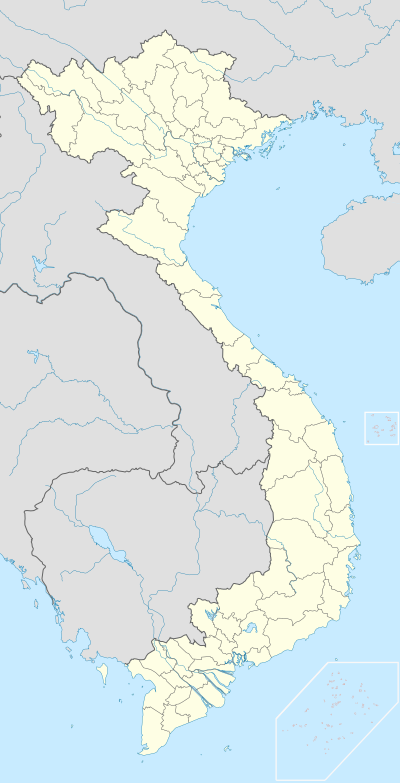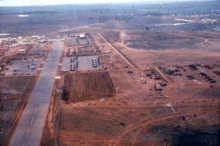Camp Holloway
Camp Holloway is a former U.S. Army base near Pleiku in central Vietnam.
| Camp Holloway | |||||||
|---|---|---|---|---|---|---|---|
Camp Holloway gate in 1965/6 | |||||||
 Camp Holloway | |||||||
| Coordinates | 13.973°N 108.031°E | ||||||
| Type | Army Base | ||||||
| Site history | |||||||
| Built | 1962 | ||||||
| In use | 1962–present | ||||||
| Battles/wars | Vietnam War | ||||||
| Garrison information | |||||||
| Occupants | 4th Infantry Division | ||||||
| Airfield information | |||||||
| Elevation | 2,460-foot (750 m) AMSL | ||||||
| |||||||
History

Camp Holloway was established in 1962. It was located along Route 19 approximately 3km east of Pleiku in the Central Highlands of Vietnam. The camp was named in 1963 for Piasecki CH-21 helicopter pilot Warrant Officer Charles E. Holloway, who in December 1962 became the first aviator assigned to the 81st Transportation Company to be killed in action.[1][2]
The 81st Transportation Company, re-equipped in 1963 with UH-1 helicopters, later became the 119th Assault Helicopter Company.
A Viet Cong attack in the early morning hours of February 7, 1965, killed eight, wounded 108 and destroyed 18 aircraft. This prompted U.S. President Lyndon B. Johnson to begin bombing North Vietnam.
In December 1965 the 170th Aviation Company joined with the 119th to make the 52d BN. The base eventually expanded to house the headquarters of the US Army's 52d Combat Aviation Battalion of the 17th Combat Aviation Group, 1st Aviation Brigade. At its peak, Camp Holloway was home to two additional UH-1 "Huey" assault helicopter companies, the 179th Aviation Support Helicopter Company Boeing CH-47 Chinook, an Cessna O-1 Bird Dog reconnaissance airplane company, a Sikorsky CH-54 Skycrane company, and other supporting units. B Troop, 7th Squadron, 17th Air Cavalry also was stationed at Camp Holloway for a period of time. B Troop, 7th Squadron, 17th Air Cavalry also was stationed at Camp Holloway for a period of time. In 1972 B Troop, 7/17th Air Cavalry was redesignated H Troop, 17th Cavalry Regiment.
At 02:30 on 26 January 1968 the camp was attacked by mortar fire and sappers from two companies of the People's Army of Vietnam (PAVN) 408th Sapper Battalion resulting in five UH-1 helicopters and one ammunition storage area destroyed.[3]
In 1973 Camp Holloway was transferred to the Army of the Republic of Vietnam. Today it serves as a training base for the PAVN.
References
- Kelley, Michael (2002). Where we were in Vietnam. Hellgate Press. p. 5–246. ISBN 978-1555716257.
- "NAMDIARIES". U.S. Army Transportation Museum. Archived from the original on 2012-06-26. Retrieved 10 January 2012.
- "Enemy Attack on US Installations After Action Report" (PDF). Headquarters 52nd Combat Aviation Battalion. 31 January 1968. Retrieved 8 June 2020.
External links
- The short film STAFF FILM REPORT 66-28A (1966) is available for free download at the Internet Archive